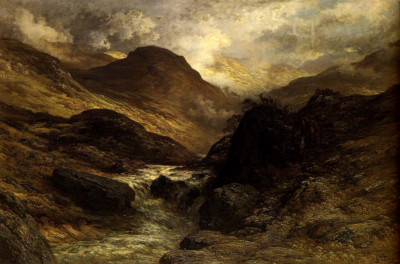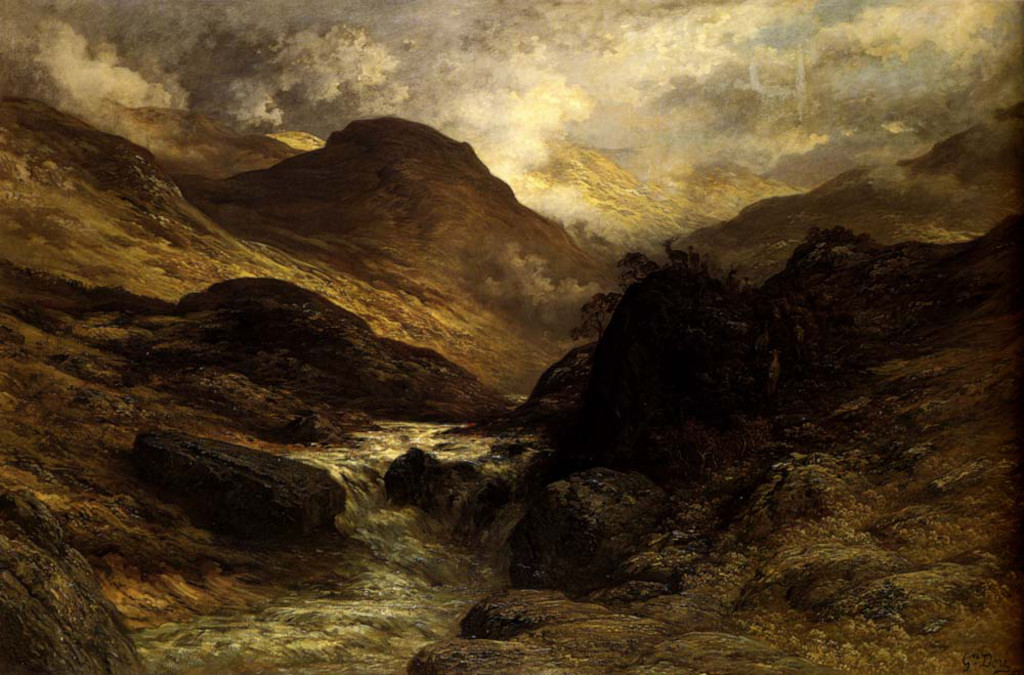A Canyon from 1878 by Gustave Doré is likely to have been completed in the artist's studio and based on his visits to the Scottish Highlands from some years earlier. He would make use of study sketches to produce a series of landscape paintings across the 1870s.
The scene found here shows a canyon running between two sloping sides, with a delightful stream trickling down towards us. The lighting contrasts, as the sun lies low, with most undulating elements covered in shadow. Towards the back we find a much brighter region, with a complex display of clouds which only allow a small section of blue sky to show through. The greenery found across his Scottish landscapes continues here though the scene is not as open as in other interpretations, such as The Scottish Highlands. He visited several times in order to appreciate the unique landscape found in this part of the UK and had already developed a strong connection to the country because of his links to several major publishers in London. We do know that he tended to use plenty of artistic license within these paintings, however, and so what we are viewing here is more of an impression of the landscape, rather than a direct realistic reproduction of what he saw at the time. Many were excited by his paintings and he had little trouble selling the best ones, but academic respect was muted in comparison to their adoration for his more successful book illustrations.
The Kremlin Armoury, Moscow, Russia owns this piece from 1878 and list it as being 169.5cm wide by 109cm tall. It is one of the few artworks by this artist to be found in Russia and is a particularly large piece, although Doré would often use large canvases for his scenes of the outdoors. He was an accomplished draughtsman, as we know, and would take small books on his person in which he would sketch some of the environments that he came across whilst travelling about. He enjoyed some salmon fishing whilst in Scotland but his main interest was always in the stunning views found here, and how they could inspire a large body of work. He was passionate about painting, and wanted to devote a good amount of time to this medium in order to master it. Ultimately he will always be most famous for his book illustrations but there is growing interest in his paintings which can be regarded as technically impressive and entirely worthy of note within his overall career. Exhibitions of his life and work do attempt to include some of these other mediums now, and perhaps in time they will be seen as more than just side interests for the artist.
As a Romanticist painter, it was perhaps inevitable that he would become involved in landscape oil painting, which perhaps is the best means for an artist to truly express himself. He would create romantic views that were not entirely accurate but this abandoning of reality made his work even more popular, delivering to the public the views of Scotland that they already imagined themselves. He returned to the country several times and never lost his love for this region, producing paintings of it for nearly a decade, even after not returning for some years. This impact helped to explain its beauty to other French artists who might also consider visiting in the following decades and over time it is likely that his paintings will receive a much greater focus, perhaps with some research aimed at documenting all of his paintings together in the same publication, perhaps for the very first time.





